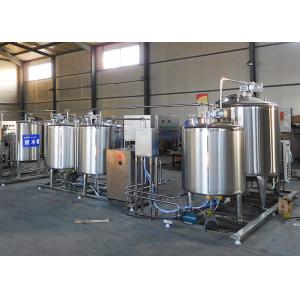

Add to Cart
Flavored Fresh Milk Production Line Pasteurized Soy Uht Milk Production Line
Pasteurized milk production process
Pasteurized milk process: raw milk storage - filtration -
preheating - homogenizing tank - pasteurization - cooling - slow
storage - filling - cleaning
Storage: Milk storage (prepared for fresh milk in the case of
insufficient milk source, ready for follow-up production •)
Filtration: purifying and filtering hair impurities, etc.
Preheating: The homogenization temperature is 50 degrees Celsius,
so the raw milk needs to be preheated before homogenization.
Homogenization: Break up the fat ball in the milk to prevent the
fat ball from floating up, improve the quality and taste of the
product, and easily absorb the body.
Sterilization: The raw milk is sterilized by pasteurization or
high-temperature sterilization to improve the food safety level and
extend the shelf life. Fresh milk after bus sterilization is
selected for hot and cold filling according to customer needs. The
sterilization time is generally about 15-30 minutes, and the
pasteurization temperature is 85 degrees Celsius. Note: The process
temperature will vary depending on the process equipment.
Slow storage: milk / yogurt slow storage, play a role in production
and filling.
Filling: Bottle, box, cup and bag can be selected according to
customer needs.
Cleaning: After the overall operation is completed, the equipment
needs to be CIP cleaned. The so-called CIP cleaning is called Clean
In Place, which means in-situ cleaning/on-line cleaning.
CIP cleaning does not decompose production equipment, but also safe and automatic cleaning system with simple operation method. Milk production line has been introduced to almost all food, beverage and pharmaceutical factories. CIP cleaning not only cleans the machine but also controls the microorganisms.
The CIP cleaning system consists of three storage tanks with weak acid water, weak alkaline water and clean water, as well as pumps, pipes and valves. The three kinds of liquids are separately circulated and cleaned to make the equipment clean and free from dead ends. In principle, customers are advised to use the cip cleaning system, but the CIP cleaning system is expensive. If the output is low, the acid-base water can be injected into the preheating tank. If the production is normal, the equipment is cleaned up to clean the equipment. Customers can also choose to clean manually.
Principle of pasteurization
In a certain temperature range, the lower the temperature, the
slower the reproduction of bacteria; the higher the temperature,
the faster the reproduction (the appropriate temperature for
general microbial growth is 28 ° C - 37 ° C). But if the
temperature is too high, the bacteria will die. Different bacteria
have different optimum growth temperatures and heat and cold
resistance. Pasteurization is actually the use of pathogens that
are not very heat-resistant. They are treated with appropriate
temperature and holding time to kill them all. However, after
pasteurization, a small number of harmless or beneficial,
heat-resistant bacteria or bacterial spores are retained, so
pasteurized milk should be stored at a temperature of about 4 ° C
and can only be stored for 3 to 10 days. , up to 16 days.
